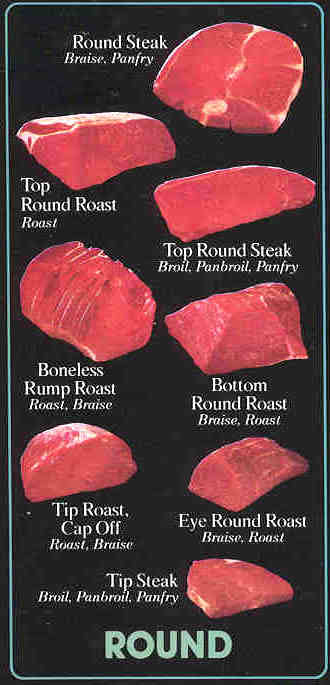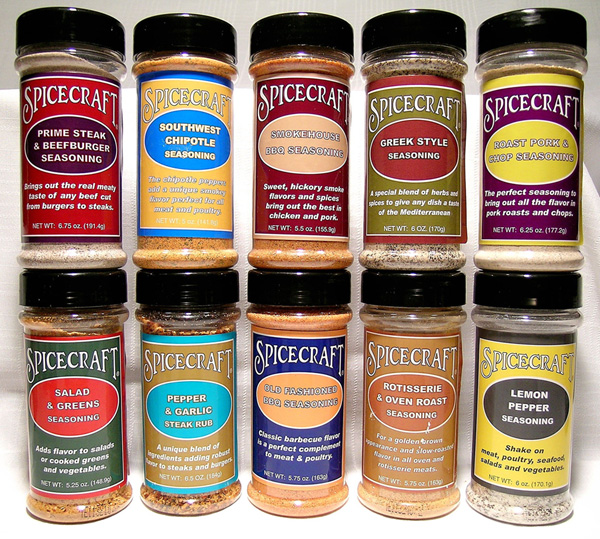|
| |
Cuts of Beef from the Beef Primal Round | Round Steak The Round Steak is identified by the round leg bone and three muscles. At the top of the screen is the top round, at the lower left is the bottom round, and lower right is the eye of the round. Panfry
Boneless Rump Roast When the rump is removed, boned, rolled and tied, a retail cut called the Beef Round Rump Roast is made. This represents a cut only moderately tender, moist heat is often used. However with a cut from choice and prime cattle, it is often cooked with dry heat. Roast
Tip Steak The Tip Steak is cut from the tip roast. Like the roast this steak is identified by four individual muscles within on large muscle mass. Cooking RecommendationsBroil, Panbroil, or Panfry
|  |
NEW. LOWER PRICES!
1 Jar WAS $14.97 - NOW ONLY $11.97 And As Always Shipped FREE in the U.S.!
2 Jars WERE $26.97 - NOW ONLY $19.97 And As Always Shipped FREE in the U.S.!
3 Jars WERE $29.90 - NOW ONLY $24.97 And As Always Shipped FREE in the U.S.!
|
|
We Only Sell Products That We Use - So YOU Only Buy The BEST Products!
Are you tired of the hassle other websites put you through just to place your order? You know.........filling out registration forms before ordering .........entering in passwords and user names..............and going through 6 pages of ordering forms and filling in more information BEFORE............you even find out out your shipping cost and total price!
Then place your order here at for the highest quality commercial meat processing products backed by years of our own use!
And We PROMISE that you will know your Total Cost BEFORE you EVEN click the buy button!
EVERY Price you see is your FINAL, TOTAL Price!! AND AS ALWAYS - FREE SHIPPING IN THE U.S.!
[And - Our FREE Shipping is our Standard USPS Priority Mail, First Class Mail or Parcel Post shipping. NOT a sub-standard 4 to 6 week shipping period
that some websites offer with their free shipping!]
|
Tip Roast, Cap Off The Beef Round Tip Roast is a rolled and tied roast that is identified by four individual muscles within one large muscle mass. Cooking Recommendations Roast | Eye Round Roast The Beef Round Eye Round Roast is a small round boneless roast. It usually has a layer of external fat on two sides. Cooking Recommendations Roast | Bottom Round Roast The Beef Bottom Round roast contains muscles which are less tender than the top round muscle. The two muscles of this roast are the eye of the round on the left and the bottom round on the right. Note the heavy band of connective tissue separating the muscles.
Cooking Recommendations
Roast | Pikes Peak Roast Also called heel of round, and boneless Pot Roast, the Pikes Peak roast is cut from low in the round, just above the hock. It contains many small muscles and lots of connective tissue. This is the least tender of the round roasts, but cooks up into a pot roast with excellent flavor. | Top Round Steak The Top Round Steak is the most tender of the various round steaks. This boneless steak consists of a large muscle called the top or inside round. Note the cover fat on the curved top surface, the cut surface on the left side, and connective tissue along the bottom. Cooking Recommendations Broil, Panbroil, or Panfry | Just Click on the links below to see a photograph of that cut, its description and nutritional data!
Round Steak
Rump Roast, Boneless
Top Round Steak
Bottom Round Steak
Eye Round Steak
Tip Roast
Tip Steak
Heel of Round
|
Roast
Roasting is recommended on large cuts of meat such as Rib Eye Roast. The meat is placed on a rack or in roasting pan and cooked until the desired level of doneness. Roasting is usually done at 350-425 degrees F.
Roasting beef entails cooking a whole slab of beef “dry” in the oven
. To Roast beef: Set the meat on a rack inside a pan to ensure it cooks evenly. It should be basted occasionally with broth or its own juices (basting with plain water will dry it out). Cook times will vary according to how well done you prefer your meat and if you’ve used specially labeled “lean” or “light” beef which take 1/3 less time to cook than regular shelf meats. Follow the instructions in the recipes or your manufacturers instructions for best results. Roasting is the most common dry cooking method and should be done at an oven temperature of 325 degrees, unless the recipe indicates another temperature. (With beef roasts 140 degrees is rare, 160 degrees is medium, and 170 degrees is well done.) You really must use a meat thermometer to obtain the degree of doneness you prefer. There are two types of thermometers. There are meat thermometers which are inserted into the thickest part of the roast and remain inserted while the meat roasts. There are also instant read thermometer which you insert during cooking to obtain a temperature reading and then remove. We prefer the instant read thermometer, as it can be used for checking many other cooking temperatures. You will find many charts that suggest the roasting times for different cuts of meat. They will typically tell you, for example, that to roast a 4 to 6 pound boneless beef sirloin roast for medium doneness, roast it two and three quarters hours to three and one quarter hours at 325. Take the lower number as the time you should start checking with your instant read thermometer. The cooking time ranges are usually too large, and the variances in actual oven temperatures too great to rely only on cooking times. Use a thermometer. Be aware that a roast continues to cook after you have removed it form the oven. It will typically add another 5 degrees while standing, so make allowance for this continued cooking. Remove the roast when it has reached 5 degrees from your chosen finished temperature. Plan to allow your roast to stand for at least 15 minutes loosely covered with foil before serving. This will allow the roasting to complete itself, the juices to set, -and give you time to prepare gravy if you wish. | Broil Broiling is done in an oven or outdoor grill. Cook the meat until it is browned on one side. Then broil the other side to the desired doneness. Broiling is very similar to grilling, and the major factor affecting the cooking time is the distance your pan is placed from the heat. If the pan is placed about 3 to 4 inches from the heat source, give a three quarter inch thick steak or chop 4 minutes on the first side and 4 minutes on the second side and check for doneness by making a small slit in the steak. With a one inch thick steak or chop, give it 6 or 7 minutes on each side before checking. |
Panbroil Panbroiling is similar to oven broiling however it is faster and more convenient. A nonstick pan is used to cook the meat until brown on both sides due to occasional turning. There is no need to add water or cover the meat. Pan-broiling means to cook the meat in a heavy preheated (hot) fry pan with no oil or water. This produces a good deal of smoke. Leave the fry pan uncovered and turn occasionally. You will have to test for the desired degree of doneness by making a small slit in the meat. | Panfry Panfrying only differs from panbroiling in that a small amount of fat is added first. Panfrying is used on ground, or thin slices of meat. Heat a small amount of oil over medium heat. Do not add the meat until the oil is hot. Leave uncovered and turn occasionally until you reach the desired level of doneness. Check for doneness by making a small slit in the meat. |
Back To Hind Quarter Cuts | Click on any jar below to go to that seasonings web page where
you can read more about that seasoning and place your order.
Prime Steak and Beefburger Seasoning (Formerly Meyers Roast Beef Rub) is our most popular shake-on seasoning. 
| Last Updated:
Monday, March 31, 2014 01:57 PM |
|




